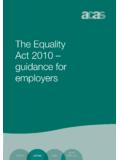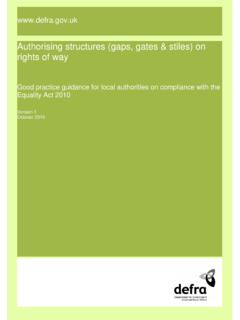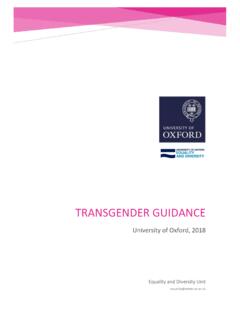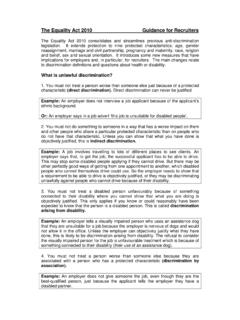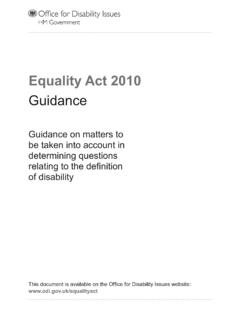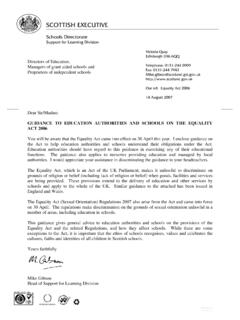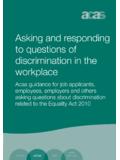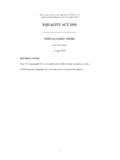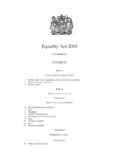Transcription of Understanding the Defra guidance on Public Path Structures
1 Understanding the Defra guidance on Public Path Structures (Gaps, Gates, Stiles, Cattle-grids etc.) The Defra guidance is focussed on local authorities and their obligations under the equality Act 2010 which incorporates the Disability Discrimination Acts of 1995 and 2005. It should be of value to: # Local Authorities # Landholders # Path users and user groups # and particularly to someone who has a physical or mental impairment that has a substantial and long-term adverse effect on his or her ability to carry out normal day-to-day activities to whom the equality Act applies.
2 This Understanding document gives some background and an overview of the 35 page Defra document. The full Defra guidance : Authorising Structures (gaps, gates & stiles) on rights of way may be found on the Defra site or direct at It is Crown copyright but may be reused in any medium if reused accurately and not in a misleading context. This Understanding document is produced by The Pittecroft Trust (registered charity) Comments to are welcome This document is online at Version 3e 20120602 2012 but may be freely reproduced if done in full Understanding Defra s good practice guide on Structures on rights of way.
3 This Understanding paper tries to do for the 35 page Defra document what our Understanding BS: 5709 paper does for BS: 5709, the British Standard for Gaps Gates and Stiles, namely give some background, a simplified overview of the recommendations, and some specific details. We hope that having read this Understanding paper, you will have grasped the essence of the Defra document. That may be all you need, but if you need more then we hope this guide will make it easier to understand Defra s document. The full Defra guidance is available on the Defra website and at The guidance applies only within England.
4 We acknowledge Crown copyright in the material where we have quoted from it. Notes: Structures is used in this guide to mean objects on or in a Public path such as stiles, gates, chicanes, cattle-grids, which prevent full and free use of the whole path width. HA80 refers to the 1980 Highways Act as amended to date. Queries and comments on this document are encouraged, send to Some Background For many years there have been differences of view amongst highway authorities, lawyers, and planning inspectors on what constitutes proper authority for, and proper definitions of, path Structures .
5 The government policy of Least Restrictive Option has helped a little now that it is quite widely accepted, for example a specification of a structure in an order, once commonly just a stile at point X has become the less restrictive a Kissing Gate at point X . But in most cases still without any attempt to specify the quality or degree of permanence of the structure. The two Disability Discrimination Acts (1995 and 2005) now part of the equality Act of 2010 gave teeth to the Government s Least Restrictive Option policy.
6 The 2005 Act made it clear that Public paths were covered by their provisions. A gate at point X would no longer be good enough To some people involved in path Structures the implications of these 1995 and 2005 Acts was clear: Structures should 1 not be authorised permanently 2 always be least restrictive and 3 always be to a defined standard But the authorities and inspectorate were unsure that this was appropriate in orders and held back. Defra , doubtless recognising that the hesitation was partly due to lack of official guidance , supported the setting up of a working party of the Rights of Way Review Committee which represents a wide range of rights of way interests.
7 This led to publication of the Defra guidance document in October 2010 . The Defra guidance addresses new authorisations. Whilst some of the guidance is relevant to the issues of existing Structures that are lawful but needlessly restrictive, that is not its main purpose. page 2 Contents Some background page 2 Contents and equality box . [this page] page 3 In a nutshell (& Recommendation A) page 4 Understanding Recommendation B page 5 Understanding Recommendations C and D page 6 Understanding other parts of Defra guidance page 7 Limitations or authorisations?
8 Structures authorised for Public safety Maintenance of Structures Cattle Grids Town and Country Planning Act 1990 The equality Act 2010 page 8 Miscellaneous page 9 Bridges Existing Structures New permanent Structures And Finally The equality Act 2010 Key aspects of this Act are the definitions of providers of services to embrace most rights of way activity and of disability to apply to far more people than those previously considered disabled.
9 Mobility difficulty, poor sight, learning difficulties, manual dexterity and so on all come within the Act. ( Defra guidance p9 B3) Public authorities must, for services which they provide, make reasonable adjustments to meet the needs of those with the disabilities above. In addition they have a legal duty to foster good relations and equality of opportunity between people with these disabilities and others. ( Defra guidance p10 B8) See also page 8 of this document page 3 In a Nutshell The Defra guidance contains four key recommendations (1 to 4, see bottom of this page) supplemented by reference to certain other matters.
10 Recommendations 1 to 4 have been slightly rephrased and referred to as A to D for the purposes of this Understanding the Defra guidance document. Recommendation A. Each local authority should have a published policy on how it will meet the requirements of the equality Act in relation to Public rights of way. This is the key recommendation. Here is Defra s non exhaustive list of relevant topics for coverage within that policy document: 1 The standards for the design of proposed Structures (paragraphs to )

